SI spoke to more than a dozen Black athletes who work in, have ties to, or have had poor experiences with, law enforcement. Their stories provide an intimate look at the tense, sometimes violent relationship between police and Black citizens.
Nothing about Leon Buchanan changed except his uniform.
Eleven years ago, Buchanan was admired for leading Morehead State to its first NCAA tournament in a quarter-century, and he became the first member of his family to graduate from college. Now he is a police officer in Lexington, an hour away from his alma mater. Earlier this month, while he worked a Black Lives Matter protest, Buchanan, who is Black, was called a traitor and told that he should be ashamed of himself.
He has heard worse. Last year, he tracked down a young girl—“12 or 13,” he says—who had run away from home, only to find that she was terrified of him. He asked why.
“I know how you police are,” Buchanan remembers her saying. “You guys kill people.”
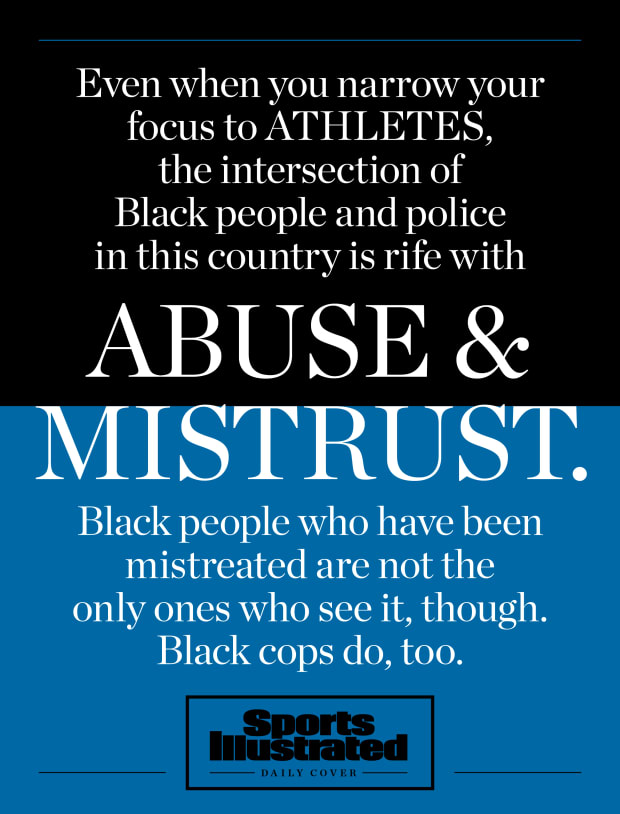
That, Buchanan says now, “felt like a knife going through my heart. I felt that in my soul.” He became a cop to save lives, not end them. When BLM protesters said that his white colleagues were racist, he says he thought: "This guy right next to me on this line would probably take a bullet for me or anyone in the crowd."
Still, Buchanan says, “I am absolutely happy they are protesting. … Based on the social injustices a lot of African Americans have experienced from the police, I understand where they’re coming from. It’s disheartening.”
Defund the police. Much of America is drawing a line, but what about those who stand on both sides of it? Buchanan and other Black cops are literally and figuratively in the middle of a heated national argument.
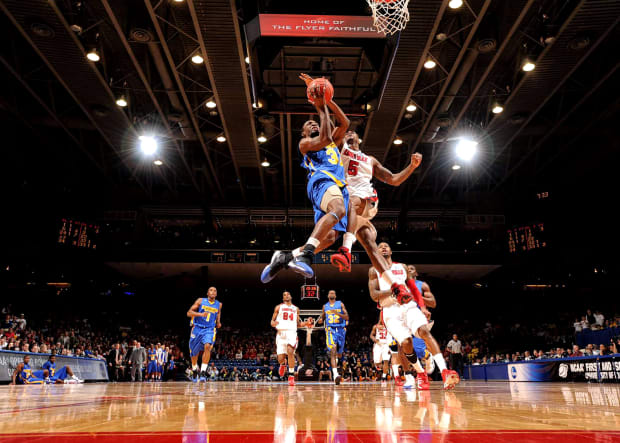
As the U.S. grapples with police brutality and systemic racism, SI spoke to more than a dozen Black athletes who work in, have ties to, or have had poor experiences with, law enforcement. Their stories are largely anecdotal, and they are presented here to inform the discussion, not to define it. Their sports backgrounds are relevant because human beings are products of their experiences, and athletes are used to being cheered by their communities. Many Black athletes find that no matter how successful or famous they become, law enforcement views them suspiciously. And if they become cops, many former admirers suddenly regard them with suspicion or outright scorn.
The video of Minneapolis police officer Derek Chauvin murdering George Floyd sparked worldwide outrage. But, like most viral videos, it gives the illusion of telling a more complete story than it does. Not every cop acts like Chauvin. The dynamics that lead to a police killing are complex, which makes them difficult to fix.
Clearly, though, there are major, longstanding, legitimate concerns about race and criminal justice in America. To understand the depth of the problems, you don’t have to go back very far. You don’t have to look beyond sports. You don’t even have to leave Minneapolis.
***
In the early-morning hours of Oct. 5, 2014, Tom Johnson, a veteran defensive tackle in his first season with the Vikings, stopped by a downtown restaurant and nightclub 10 blocks from Minnesota’s stadium. His team was on a bye that week.
Johnson valeted his car and walked inside. He bought drinks for himself and two teammates, downed a whiskey ginger and eventually went back out to hand his ticket to the valet. Facing what he was told would be a 20-minute wait, in 35-degree weather, he stepped back into the club’s entryway. Video surveillance would show that 11 patrons remained inside the bar, but only Johnson was asked to leave. He says a bouncer told him his Timberland boots violated the club’s unwritten dress code.
Johnson’s attorneys later argued in a U.S. District Court memorandum that what happened next can be explained by one simple fact: Johnson is African American.
Two off-duty Minneapolis police officers, Patrick McCarver and John LaLuzerne, approached. They were already violating numerous department policies, including working off-duty inside of the club. They shouted at Johnson to leave. McCarver pushed Johnson toward the door, then sprayed MPD-issued pepper spray into his face. Johnson couldn’t see, his eyes stung, his nose ran and he was “spitting up.”
He found a planter outside and sat down. An employee rushed over, offering a glass of water and a face towel. Johnson, realizing he could no longer drive, called a car service that the Vikings offer players whenever they needed a safe ride home. While he waited for his ride, he took photos and video of the officers, at which point McCarver swatted Johnson’s phone to the ground, shattering the screen. As Johnson tried to pick up the device, McCarver aimed his department-issued Taser at Johnson’s head. Then both officers discharged their weapons into Johnson’s back and tased him for at least 14 seconds, while the officers laughed and cracked jokes.
Says Johnson, six years later: “I couldn’t breathe.”
Eventually the officers forced the 6' 3", 280-pound lineman to the ground and handcuffed him. Johnson was arrested and charged with trespassing, disorderly conduct and interfering with a police officer.
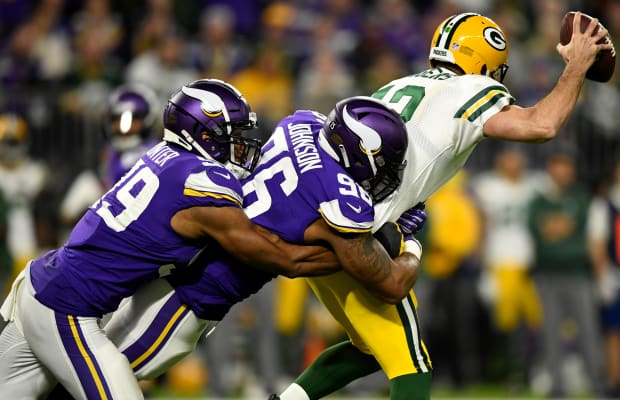
In the aftermath, the Vikings’ white, no-nonsense coach, Mike Zimmer, asked Johnson what he had done wrong. But white general manager Rick Spielman, who has six Black children, understood immediately that Johnson might not have done anything at all. Spielman says that his kids have been profiled by police before—once while driving his wife’s expensive car, and another time at a restaurant with friends. He has watched security guards follow his children around stores. One son described to Rick being pulled over by police, and how his heart dropped because he didn’t know what might happen next. Spielman says he has “seen the world through [his kids’] eyes, which is a totally different lens.”
The difference between Zimmer’s and Spielman’s reactions was not lost on Johnson, and he understands it. “I got mad respect for Zim,” Johnson says, “but if you’re not a Black person, or you haven’t experienced this, you just assume the person in authority is doing the right thing.”
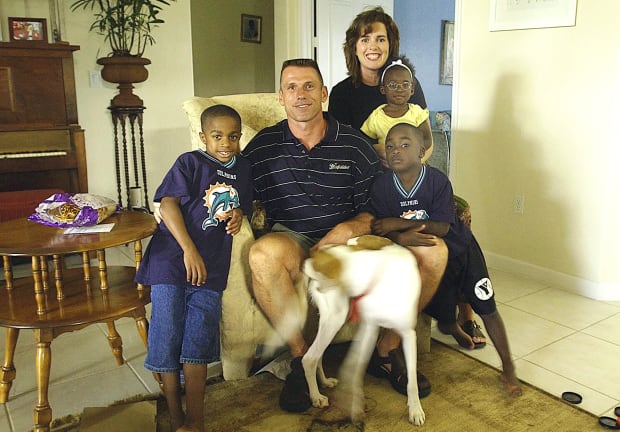
Read our full interview with Rick Spielman
Ultimately, Johnson rejected a plea deal because he could afford good lawyers. In court, the officers argued he had been aggressive toward them, but surveillance video showed otherwise. A jury needed just 15 minutes to dismiss all charges, and in April, Johnson won $475,000 in a civil case against the Minneapolis Police Department.
The officers he dealt with won too, though. In the months following the incident, they were each given an award of merit, and McCarver was promoted, according to the civil complaint.
A few weeks after Johnson won his case, he watched on video as another Minneapolis police officer put his knee in George Floyd’s neck, and he heard Floyd utter those now-famous words: “I can’t breathe.”
“I could have been just like George,” Johnson says. “I could have been dead.”
***
Thomas Guynes can speak for hours on institutional racism in America. He is the descendant of slaves, and he points out that modern-day police forces have roots in Southern slave hunting. He knows the lyrics of “The Star-Spangled Banner” that Americans don’t sing, the forgotten verse about slavery. (No refuge could save the hireling and slave / From the terror of flight, or the gloom of the grave.) Guynes’s grandfather served in World War II, and when he came home, Guynes says, “he still had to ride in the back of the bus.”
Even then, when Guynes watched the video of George Floyd dying, his very first thought was: “piss-poor police work." An offensive tackle for the Arizona Cardinals in the late 1990s, and later in the NFL Europe, Guynes is today a deputy sheriff in Ypsilanti, Mich. And he says, "I've never been in a situation where I held somebody down for nine minutes [and] there's four or five of us on one guy. ... There's no reason.”
On Chauvin’s face he saw “overall apathy, which to me just spoke evil. He just didn't care. … Inhumane.”
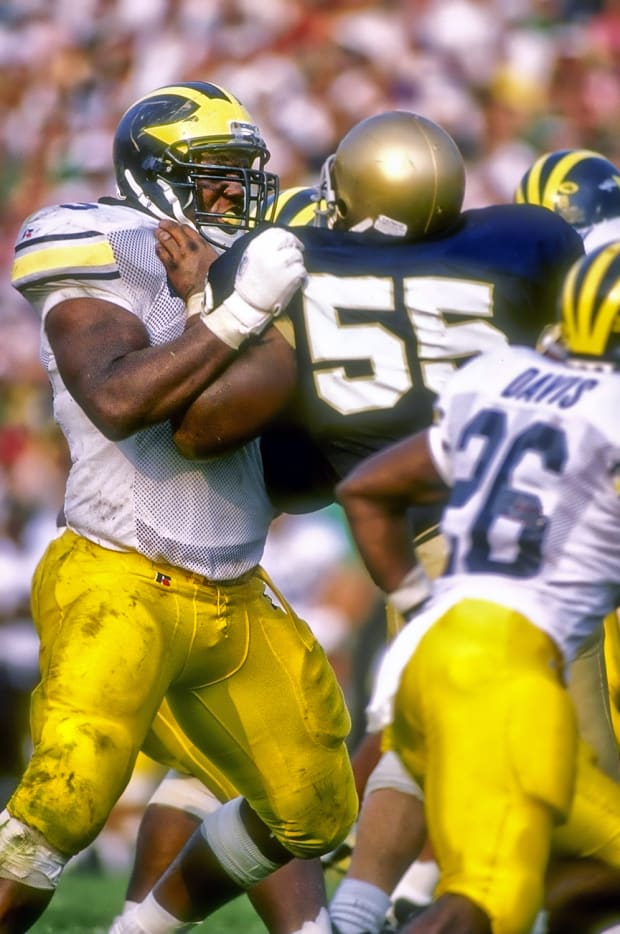
For someone who views police as inherently and across-the-board racist and violent, it would be easy to explain Chauvin’s actions. Guynes sees police as people just as prone to acts of goodwill or malice as any other group. And so his first questions about the video were about culture. Why did Chauvin think he could act that way? Why didn’t the other officers stop him?
Why, essentially, did Chauvin act out his darkest instincts, with no fear of reprisal?
If Chauvin is a racist with a temper, there are plenty more like him in America, inside and outside of policing. Guynes believes some departments could do a better job of vetting, but already “we take psychological tests coming in.” People, he says, can “bulls--- to get the job.”
If police departments cannot control their officers’ hearts, they can regulate their actions. Guynes says these departments need to adopt a culture of accountability—a culture of, as Leon Buchanan says, “police policing each other.” That, though, requires training, retraining, open communication and trust. Says Guynes, “I don't think that's just a law enforcement thing. That's a management thing.” The difference between law enforcement and almost any other profession: Typically, a poor culture can lead to bankruptcy. In policing, it leads to George Floyd being killed.
Guynes compares police departments to college football programs. If senior players are taught well, good values become self-perpetuating. But if they’re not? Then you have problems. Young officers, like young players, tend to follow veteran leaders, or those with the strongest personalities. They tend to protect and stand up for one another, instead of strictly for what is right.
Guynes, asked whether the other Minneapolis police officers looked scared to stand up to Chauvin, says: “It’s not so much ‘[I don’t know how to] go against you’ as ‘I don't know how not to go with you.’ ”
When Guynes himself became an officer, he requested to work in blue-collar Ypsilanti instead of in neighboring Ann Arbor, where he played college ball, because “I just wanted to be, as we say, in the s---. … I'm the guy who, if I had lived in ancient Rome, would have given up my citizenship to go be a gladiator.”
Police work tends to attract people like Guynes. Good officers, though, control their emotions, and good departments encourage and reward them for doing so. Tracking down criminals can provide a rush and a sense of accomplishment. But for all the images, real and cinematic, of police officers firing guns or wrestling suspects into submission, Guynes says his primary objective is to defuse. He’s 6' 5"—“an imposing figure, I get it,” he says. “But I’ve never been a bully cop. I try to hit you with reason and rationale and some empathy and softer tones.” He tells young officers, “ 'If you have to go to your gun, you’ve lost. Your most important weapon is your brain; second, your ability to talk to people; third, your heart.' I'm a peace officer. That's what it should be. When you leave me, I want you to feel like that was a positive interaction with law enforcement—even if I'm taking you to jail.”
Confrontations can be tense, and officers need to stay focused on the goal: to defuse. Departments that tacitly encourage the use of force end up with officers who act unprofessionally—and there is overwhelming evidence that Black citizens pay the most severe price.
“I’ve been blessed to have a high level of diversity in my upbringing,” says Guynes, “so that has served me well in law enforcement. But when you have people that don't necessarily have that same level of diversity in their everyday life, I think they struggle. Your own implicit biases kick in.”
***
Implicit biases put Bucks guard Sterling Brown on the cold, damp Milwaukee pavement. It didn’t matter that he was a highly-paid professional basketball player, the least likely person to rob a pharmacy; that he is the son of a police officer; or that his transgression—double-parking in the handicapped area of an empty Walgreens lot at 2 a.m.—was not even criminal. What mattered was that he is Black.
As Brown walked back from the drugstore to his car on Jan. 26, 2018, he saw an officer, who called for backup. Brown says he remained calm as more police arrived, until there were eight total. He remembers them saying things like, “I’ll do what I want, all right?” and “What is wrong with these people?” Then officers kneed Brown in the groin and threw him to the pavement. One officer drew his gun before sinking a Taser into Brown’s back. Another stomped on his leg with both feet. Brown suffered so much physical damage that the officers called an ambulance. Eventually, one even told Brown that he hoped the Bucks would make the playoffs.
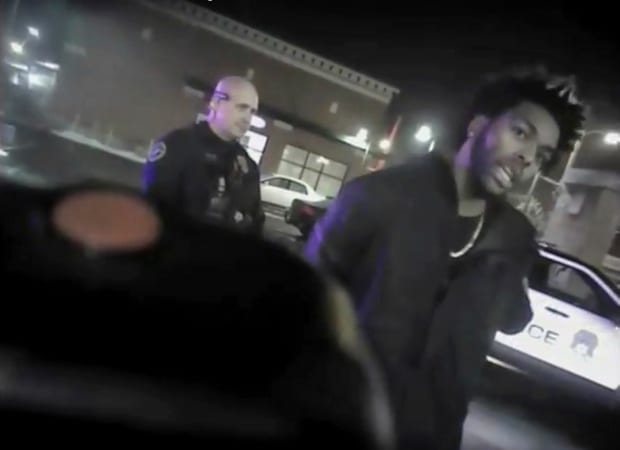
Read our full interview with Sterling Brown
That incident was captured on video and condemned by the Milwaukee Police Department, which briefly suspended three of the officers. In the subsequent lawsuit that Brown filed, his lawyer cited one punishing statistic: In Wisconsin, unarmed Black citizens are almost 16 times more likely than unarmed white citizens to be shot by officers.
After that episode, one of the eight officers, Erik Andrade, posted taunts and racist messages on social media: Nice meeting Sterling brown of the Milwaukee Bucks at work this morning! Lol#FearTheDeer. Commenting on a picture of Kevin Durant, Andrade wrote: Damn ….more naps than preschool! Lmao. On a post claiming that Black people often lied to police, alongside a snapshot of Brown, he wrote: A little truth to those who want to listen. And: Had great time workin replacement … 5+ OT [hours of overtime] and use of force. Lol.
Andrade was fired for his posts, which the Milwaukee PD called “racist and derogatory,” but Brown’s civil suit is ongoing. He turned down a $400,000 settlement offer last year. Meanwhile, he wonders how much Andrade’s attitude had infected the cops who “could have killed me over a parking violation.” He finds it telling, too, how people have responded to the publicly released video of him lying face down on the pavement that night two years ago. His white friends express shock and outrage; they can’t believe something like that might happen today. But his Black friends, even those friendly with law enforcement, are not at all surprised.
***
Today Derek Chauvin is awaiting trial on second-degree murder and second-degree manslaughter charges. But if a guilty verdict seems certain, Brian Watkins can tell you: It’s not. The San Diego criminal defense attorney recounts the story of two white police officers, a retired NFL linebacker and a country that wasn’t ready to hear the truth.
On July 24, 1999, officers Timothy Keating and Robert Wills were called to an apartment in Mission Beach, Calif., after a resident came home to find Demetrius DuBose—a former second-round pick of the Buccaneers who lived at the same complex—inside, sleeping. The resident told DuBose to leave, and he did, after his roommate intervened and explained the situation.
Then the police arrived, responding to what they thought was a burglary. They found DuBose unarmed, and initially he cooperated. According to the roommate, though, the police sprayed DuBose with Mace, at which point he fled. The cops told a different story: DuBose reached for their nunchucks (two foot-long plastic sticks joined by a rope) and was ready to attack them. Whatever happened, the official record shows cops shot him 12 times, including five in the back, and twice more in his shoulder blades.
DuBose died. An autopsy showed he had cocaine, ecstasy and alcohol in his system. The district attorney deemed the killing to be justified, and federal prosecutors found no evidence that the officers had violated DuBose’s civil rights. Watkins, on behalf of DuBose’s family, pursued a civil case, and that failed. The officers benefited from qualified immunity, a statute that raises the burden of proof against law enforcement to an almost impossible standard.
“If they are in fear of their life or their safety, they are allowed to kill you,” says Watkins. “It is a federal law.”
Qualified immunity, much like perjury, forces prosecutors to prove what’s inside a person’s mind. And how do you prove a cop wasn’t scared for his life? “The system is set up to protect [police],” Watkins says. “Officers, once they are involved in a shooting … they don’t have to talk until they’re given a lawyer by the police union. Then they get their story straight. I thought he had a weapon. … I thought he had a knife. … Those are things you hear every time.”
Many officers may not be conscious of this legal protection. But Watkins believes it effectively makes law enforcement above the law. Combine that with the instinct of some police officers, he says, to protect themselves first, rather than protect the citizenry, and “that’s why you see all these unarmed Black men being shot.”
A disparate group of NFL players—from Black activist Malcolm Jenkins to image-conscious white quarterbacks Tom Brady and Drew Brees—recently signed a petition calling for an end to qualified immunity. On Monday, however, the Supreme Court declined to reexamine the issue.
Now imagine how the killing of Demetrius DuBose might play out today: an unarmed, Black former Notre Dame star shot 12 times—seven from behind—by white police officers.
“I think the legal result would be the same because the law is the same,” says Watkins. “But the public reaction would be different. Now people realize police lie and they do things wrong. Just because you say he went for a gun, that doesn’t mean he did … DuBose was shot in 1999. Rodney King was ’92. Before Rodney King, nobody believed police would use excessive force.”
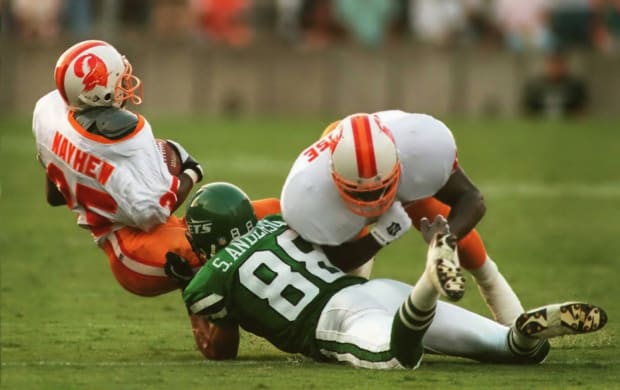
***
That camcorder video of Los Angeles police beating a defenseless Rodney King changed America. But how much did the country change? And why did so many white people believe a video but not what Black people had been telling them for decades?
“Black people,” says activist and sociologist Harry Edwards, “have never been considered by the white mainstream to be credible witnesses to their own experiences.”
Edwards joined the Black Panther Party in 1968, after Oakland Police shot the group’s first member, 17-year-old Bobby Hutton, 17 times, despite his surrendering and stripping off his clothes while walking backward with his hands up. Edwards believed that images—starting with Polaroids that Panthers handed out in the 1960s, so their snapshots could capture mistreatment—would force law enforcement to rethink its methods. “Instead,” he says, “we watched a man get shot in the back. We saw Oscar Grant (in 2009, also in Oakland) handcuffed on his stomach with two cops on top of him as another pulled out his gun, shot him in the back and killed him. … Police culture in this society is messed up and has been for some time. It's not just a thing of bad cops. The good cops are operating in a rotten system.”
If this country has made progress over the last 40 years, it’s been largely due to technology. People reacted so strongly to King’s beating and Floyd’s death because they saw them. Now an entire society looks to video replay—to absolve, to confirm suspicions, to avoid injustice.
In May 2005, LeVelle Moton—a former North Carolina Central shooting guard who was by then coaching high school at Sanderson High, outside Raleigh—was pulled over in his Yukon Denali. Riding shotgun that evening was Raymond Felton, fresh off winning a national championship with North Carolina. Moton was on the phone with his mother when he noticed a squad car had started following him. He told her he would call her back, because he expected to be pulled over. “No,” she said. “Stay on the phone with me.”
Moton says one officer pulled him over, ran to his door and tried to yank him out of the vehicle. Another officer pointed a gun at his head. Then the first cop snarled, “Turn your ass around.” Moton says the police hadn’t requested his license or registration, and when he asked why they had pulled him over the officer with the gun pushed the barrel closer to Moton’s face while his partner kicked open Moton’s legs and demanded to search the truck, shouting, “You’ve got dope on you!” Moton could hear his mom screaming through the phone. He wanted to call for her, like Floyd would later call for his mother on that street in Minneapolis.
The officers finally asked Moton to retrieve his license, but he declined, saying, “I’m not giving you a built-in excuse to shoot.” Instead, he told them his license number, having memorized it as soon as he could drive, one of many precautions the older Black men in his neighborhood had passed down to children who needed to know how to deal with police.
Eventually the officers noticed Felton in the passenger’s seat—and suddenly they became big fans. They took Moton’s handcuffs off. One officer even extended a hand, saying, “Man, I’m sorry. You fit the description. I just don’t want you to think I’m an asshole.”
“You’re way too late for that,” replied Moton, who says he was never told what possible suspect’s description he matched.
Now the head coach at his old school, North Carolina Central, Moton remembers how he felt getting back into the truck with Felton after his run-in with police. “I had decisions to make,” he says. “I wasn’t sure any of this was captured on video; it was going to be my word against theirs. And where I'm from, you don't win.”
Yes, video can expose wrongdoing, but it does not seem to prevent it. Edwards points out that bystanders filmed Floyd’s killing in Minneapolis and shouted at the officers standing watch to let him go. Edwards calls the idea that those same officers could simply be trained better “vomitous.” “That’s not a training problem,” he says. “It’s a recruitment problem that sustains the culture of criminalization of people of color. It’s not enough to just put Black in blue. We need a new system. You cannot set up a system of justice and have that system set up with concepts that are antithetical to justice.”
Read our full interview with Thabo Sefolosha, who had his leg broken by police in 2015
***
Edwards and Anita Ortega have stood on opposite sides of the same picket line. But, really, they’re on the same side of this issue. Ortega, like Edwards, has seen the same story repeat for decades—unrest and inaction, unrest and inaction. . . . Instead of trying to fix this existential crisis by joining the Black Panthers, though, she tried to fix it by joining the police.
In 1965, when she was nine, Ortega watched her South Central Los Angeles neighborhood burn in the Watts Rebellion, which was spurred by rumors of excessive police force in the arrest of a Black man named Marquette Frye. Outside her living room window, Ortega saw flames burst and black smoke rise while sirens wailed in the background and her neighbors looted the businesses on her block.
“Momma,” she asked, “are they going to burn our house next?”
Back then, Ortega never saw any police officers who looked like her, a person of African and Puerto Rican descent. By the sixth grade, she decided she wanted to work in law enforcement, to help change the system for her people—for all people—from within. Her father had spent time in jail, and she wanted to “diminish the fears that the African American community had.” Ortega went to UCLA on a partial scholarship, won a national title in 1978, and, six years later, after undergoing extensive training, she joined the LAPD.
Ortega worked in that department for 32 years, starting as a beat cop investigating gang violence, robberies and murders, and rising to the city’s first female Black area captain, where she oversaw nearly 500 officers. She watched the LAPD become more diverse and witnessed reforms firsthand—consent decrees and pushes to improve community relationships, body cameras, social training, the whole gamut.
“It’s still not enough,” though, says Ortega. “It needs to be deeper. The job is very complex, but let’s not get that confused. Some things are inexcusable. The problems inherent in the system have not been eradicated.”
Ortega argues against blanket qualified immunity and for an overhaul of the recruitment system. (She would, for example, mine applicants’ references to gauge their exposure to diversity.) She wants a reexamining of police unions, as well as the district attorneys and judges they support. Were it in her power, she would tear down monuments to Confederate figures and other racists. She encourages citizens to know their local police’s use-of-force policy, and she advocates for the creation of a universal policy across the U.S., whereas today they vary from department to department.
Both Edwards and Ortega have been heartened by the latest protests, which started in early June and are still going strong. Neither wants the world to return to normal when the bullhorns and the signs are packed away, when the news cycle moves on. Edwards believes the protests have hit on something important: the need for honest dialogue and better leadership, starting with “truth and reconciliation.”
“Don’t just leave it at protesting,” he says, citing the need for strategic, disciplined follow-through.
All of this speaks to the need for something far more transformational than the usual Band-Aid tweaks. “We have to see change, but it shouldn’t take this type of destruction to make it happen,” Ortega says. “That’s all people are trying to do: get attention and make the changes that are necessary so there’s equality, respect and justice. That’s it.”
Ultimately, this issue is not just about police and the citizens they are supposed to protect. It is a battle between people's best and worst impulses.
Leon Buchanan believes in law enforcement. But he also tells friends: If you’re pulled over, call me. Put the phone on speakerphone. Then keep your hands on the steering wheel. Stay calm. Don’t reach for anything—even your license and registration—until you’re asked.
“I've had a lot of friends call me at 2, 3 in the morning,” Buchanan says. “But I still answer the phone.”
***
Derek Chauvin is an example of the worst kind of cop, but he is also proof, to some, that a civil society needs officers, because even the best society will always have Derek Chauvins, and a well-trained police force would stop many more than it shelters.
“I'm always gonna fall back to the common denominator of human nature,” Guynes says. “For whatever reason, there is a need for us to feel superior in some way. And typically, we end up making somebody else feel inferior … unless you're really comfortable with who you are.”
Being comfortable with who you are entails challenging assumptions about yourself. “When I started on the job,” says Guynes, “I was like, ‘Why am I always pulling over Black people?’ I felt like I was profiling my own people.’ ” Ultimately, he concluded that he was just working areas heavily populated by Black people, not targeting people because they were Black. But he had gone through the exercise, at least. He had questioned himself.
What if more people underwent such self-examination and made the effort to understand others? That may sound like a naive request, but Moton, the college basketball coach who saw a gun pointed at his head, believes the world is changing in a fundamental way. He’s seen protests in Germany, Italy and France, demonstrators wearing Black Lives Matter T-shirts, and police officers kneeling in solidarity. He’s seen empathy and understanding, witnessed conversations. “Fifty years from now,” he says, “we’ll look back and say, Wow, that was historic. This is that moment. People will remember where they were today, the same way my mom spoke about the day Martin Luther King Jr. died.”
That’s one view. Guynes has another: “Ten years from now, I guarantee, we'll be right back here. And that's not a white-Black thing. That's not a law enforcement-against-society thing. That's just a people thing.”
Forty-five days after the Minneapolis police department lost to Tom Johnson in court, one of its officers knelt on George Floyd’s neck for nearly nine minutes and killed him on the street. It feels like the same tragic story will repeat forever. Yet even Johnson sees progress.
Shortly after Floyd was killed, an old teammate of Johnson’s, Brian Robison, posted a video on Instagram. He’s white, and though he knew his Black friends were hurting and needed help, he also thought most cops were good. Robison’s father had served for 29 years in the Houston police department. “All lives matter,” Robison said.
Robison sent Johnson the video and Johnson responded by saying he appreciated most of the sentiments, but he took exception to “All lives matter.” He sent Robison a now-familiar meme, a post that asked, essentially: If your wife said, “Do you love me?” would you answer, “I love everybody”? Or if a friend told you that her father had died, would you respond, “Well, everybody’s dad dies”?
Says Robison: “That opened my eyes. … At the end of the day, I’m white. I won’t fully be able to understand what people of color go through.”
The video of George Floyd will linger for decades. But the video of Brian Robison saying “All lives matter” is gone. He deleted it.